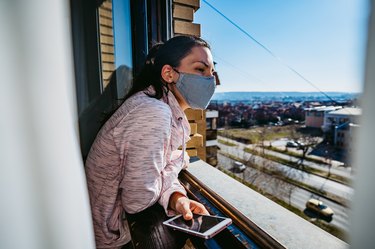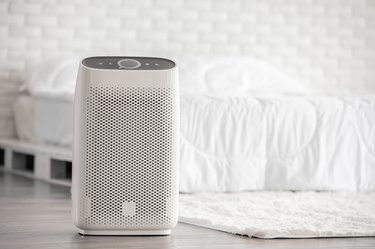
Months into the COVID-19 pandemic, there are still many unknowns about the virus, including all the ways it can be contracted. And as the colder weather crops up, there's understandably more concern about the ways the novel coronavirus can spread indoors.
While the major mode of infection appears to be through close contact between people and exposure to respiratory droplets when a sick person coughs, sneezes or speaks, the Centers for Disease Control and Prevention (CDC) have recently revised their guidelines to include airborne transmission.
Video of the Day
Video of the Day
This means that once the virus gets into the air via respiratory droplets, it can linger there for minutes to hours, potentially infecting others even after the sick person has left the space.
While airborne transmission doesn't appear to be a big problem outdoors where the virus is more likely to disperse, confined spaces can boost the odds of infection. This is especially important to consider as colder weather approaches and more people begin to spend time indoors.
That's why ventilation — the amount of fresh, outdoor air flowing into an indoor space — becomes a vital factor in disease prevention. Indeed, both the CDC and the World Health Organization report that poor ventilation indoors may increase the spread of coronavirus.
Get tips on how to stay healthy, safe and sane during the novel coronavirus pandemic.
While good ventilation alone isn't enough to stop the spread of the virus, it can — in combination with wearing masks, social distancing, proper hand hygiene and routinely disinfecting surfaces — reduce transmission rates, according to the Environmental Protection Agency (EPA).
So, how can you tell if an indoor space is well ventilated? We spoke to experts, who recommend asking yourself the following questions to better understand a room's risk.
1. Does the Space Feel Stuffy?
"If a place feels unusually stuffy or smelly, it could be an indication of low ventilation rates," Max Sherman, PhD, residential team leader for the Epidemic Task Force at ASHRAE, a leading global authority on sustainable technology for the built environment, tells LIVESTRONG.com.
But detecting a poorly ventilated room isn't usually that simple.
"People are terrible ventilation sensors, at least as far as Indoor Air Quality (IAQ) is concerned," Sherman says. "The result is that we cannot necessarily feel that a space is poorly ventilated like we can feel that it is poorly heated."
To make matters worse, "a lot of things that could build up in the air are not easy to sense, including viruses, carbon monoxide, formaldehyde and other hazardous particles," he adds.
Since it might be tough to tell whether a room is adequately airy, your best bet is to practice social distancing and wear a mask when inside with others.
Indeed, a September 2020 study published online in the Journal of Fluid Mechanics found that face coverings halted the momentum of people's breath and decreased the spread of droplets, thus reducing the number of contaminants recirculated through the room by ventilation.

2. Does the Space Feel Muggy?
"There is evidence to suggest that keeping the relative humidity in the 40 to 60 percent range reduces the risk of infection," Sherman says. "This also happens to be in the optimal thermal comfort range, which means it's a win-win."
That said, studies suggest that weather and climate-related humidity may reduce the transmission of COVID-19, says Brian Chow, MD, a professor of infectious disease at Tufts Medical Center. "However, we do not know what this means for artificially generated indoor humidity," Dr. Chow adds.
Case in point: An August 2020 published in the Physics of Fluid concluded that high humidity can lengthen the airborne lifespan of medium-sized respiratory droplets by as much as 23 times.
Related Reading
But Dr. Chow says we should interpret these findings with caution since the research was conducted in a laboratory setting, which could vary greatly from real-life environments. "We see this often — there will be a disconnect between a study looking at the biology or physics of a disease that does not translate to the observed epidemiology of disease transmission."
Consequently, Dr. Chow adds that he wouldn't recommend using indoor humidifiers solely to prevent the spread of COVID-19.
"Cleaning the environment (wiping down high-touch surfaces regularly) is probably a much more effective way of preventing COVID infections than controlling ambient humidity," he says.
Sherman agrees: "While humidity control might be a help, filtration, ventilation and disinfection are usually going to be higher-priority approaches."
3. Is Fresh Air Circulating?
While not definitive of safe air quality, "a high degree of air motion, especially a draft, might be an indication of increased ventilation or filtration," Sherman says.
The ideal environment is one where lots of fresh outside air is circulating indoors.
"Proper ventilation will carry virus particles out of the enclosed space, preferably ventilating it outdoors, and bring in fresh air (either from outside or filtered) to replace the expelled air," Dr. Chow says.
In short, pumping in outside air helps to dilute any contaminants, such as viruses, in a building.
Logically, open doors and windows are the clearest indications of good, natural ventilation. But even with these precautions, the air exchange may be inadequate if there's not much of a breeze or the inside and outside temperatures are similar, according to the EPA.
How to Increase the Natural Ventilation of a Room
To increase natural ventilation, the EPA recommends the following strategies:
- Open several windows or doors, preferably at opposite ends of the space (but not directly across from each other) to increase cross-ventilation.
- Open the highest and lowest windows (especially on different floors).
- Use indoor fans and place them in front of windows either facing toward the window (blowing stale air out), away from the window (blowing fresh air in) or ideally, a combination of both.
- Position the fan so that its airflow does not blow directly from one person to another.
What about using an air conditioner to increase indoor ventilation? Unfortunately, "most window air conditioners only recirculate indoor air," Sherman says.
However, during colder weather, natural ventilation through open windows and doors may not always be possible or practical. In these cases, most commercial buildings utilize mechanical heating, ventilating and air-conditioning (HVAC) systems to pump outside air indoors.
"Since running your HVAC system filters the air as it is circulated, it can help reduce airborne contaminants, including viruses, indoors," according to the EPA.
The issue is, "we can observe open windows and assume there is enough air, but if the ventilation is provided by the mechanical system, we don't have a good way of telling whether it is enough," Sherman says.
"A high degree of air motion, especially a draft, might be an indication of increased ventilation or filtration."
While building codes, which can vary by location, must specify certain ventilation requirements to help protect from normal IAQ issues, only a qualified HVAC technician can perform tests to see if an HVAC system, say, in a restaurant or gym, is operating as required, Sherman says. The average person won't be able to tell whether a business's HVAC system is working properly or if a space is adequately ventilated.
"Just like assuming the structural engineer did [their] job and the building won't fall down, we might have to assume the HVAC engineer did [their] job and there is sufficient ventilation," Sherman says.
If you do have access to an HVAC system, the EPA recommends running the system continuously to filter the air 24/7 and upgrading to a higher efficiency filter (or the highest-rated one that your system can accommodate). Both strategies will help to reduce the spread of the coronavirus.

4. Is There an Air Purifier?
Air purifiers, also called air cleaners, can also help decrease the number of airborne contaminants, including viruses like COVID-19, in a confined space, per the EPA.
In many cases, more viral particles in the air can be removed through filtering than simply ventilating, Sherman says.
"Recirculating air with MERV (Minimum Efficiency Reporting Value) 13 or better filters can provide even more risk reduction at lower costs," he says.
MERV is the system created by ASHRAE to rate particle filters on a scale from one to 16, where higher numbers are better as they filter more and smaller particles. For reference, ASHRAE recommends MERV 13 filters (or higher) to reduce the long-range transmission of the small respiratory particles that carry the SARS-CoV-2 virus, Sherman says.
HVAC systems have built-in air filtration, but for smaller spaces or places without mechanical systems (like many residential homes), a portable air cleaner can be extremely effective. However, not all air purifiers are created equal, Sherman says. When purchasing an air cleaner, first consider the quality of the filter. High-efficiency particulate air (HEPA) filters are the gold standard.
Related Reading
"High-efficiency particulate air filters [which score above the MERV range] are used in hospitals, in industry and on airplanes to filter the air before recirculating" and can filter out extremely small droplets and aerosols, Dr. Chow says.
"In addition to HEPA filtration, some of these devices also offer disinfection" as a secondary step to catch any pathogens that escaped through the filter, says Sherman, adding that the most reliable, well-studied disinfectant method is ultraviolet germicidal irradiation (UVGI). While other approaches like bipolar ionization exist, they have not yet undergone rigorous third-party verification.
Keep in mind, though, that some disinfection methods have the potential to create ozone, which can be bad for your health, Sherman says. Before you buy, check out the list of hazardous ozone-generating air cleaners compiled by the California Air Resources Board.
And remember: While a portable air purifier is a helpful tool, it alone can't shield you from catching the coronavirus. Wearing a mask, social distancing and proper hand hygiene is still your best protection against contracting COVID-19.
5. Is There a Carbon Dioxide Detector?
Carbon dioxide (CO2) is not actually a contaminant, but calculating the amount of CO2 (measured in parts per million or ppm) in a room may be used as an indicator of ventilation per person since people generate CO2 as they breathe, Sherman says. Essentially, more CO2 means more exhaled breath, and, potentially, more virus in the air.
Sherman recommends keeping an indoor space's CO2 concentration at 1,000 ppm. For reference, outdoor concentration is typically 400 ppm.
A CO2 detector can give you a general sense of what's going on with the air and ventilation, but Sherman stresses that it's not a perfect gauge. Higher levels of CO2, even at 1,600 ppm, don't pose a health risk on their own, and fluctuations in CO2 concentrations, which will likely vary from room to room, are not a big deal.
Concerned About COVID-19?
Read more stories to help you navigate the novel coronavirus pandemic:
- Centers for Disease Control and Prevention: “How COVID-19 Spreads.”
- World Health Organization: “Transmission of SARS-CoV-2: implications for infection prevention precautions.”
- Journal of Fluid Mechanics: “Effects of ventilation on the indoor spread of COVID-19.”
- Physics of Fluid: “Transport and fate of human expiratory droplets—A modeling approach.”
- Environmental Protection Agency: “Indoor Air in Homes and Coronavirus (COVID-19).”
- California Air Resources Board: “Air Cleaners & Ozone Generating Products.”
Is this an emergency? If you are experiencing serious medical symptoms, please see the National Library of Medicine’s list of signs you need emergency medical attention or call 911.